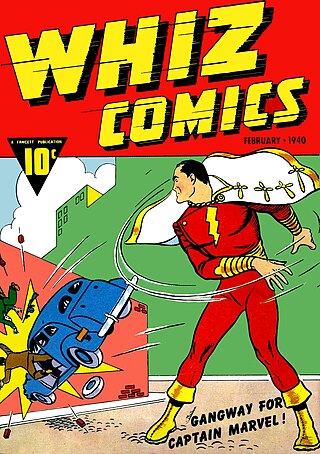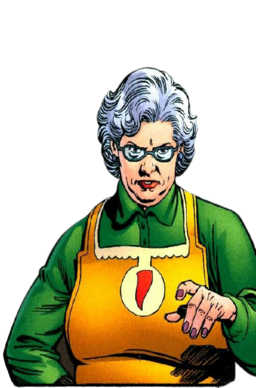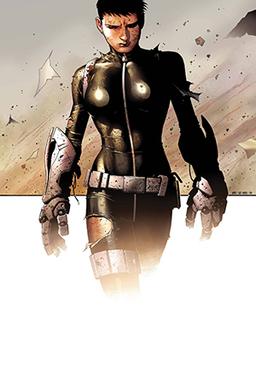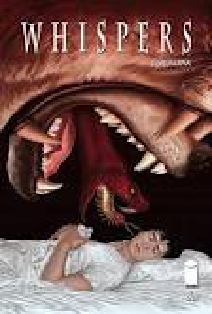
Watchmen is a comic book limited series by the British creative team of writer Alan Moore, artist Dave Gibbons and colorist John Higgins. It was published monthly by DC Comics in 1986 and 1987 before being collected in a single-volume edition in 1987. Watchmen originated from a story proposal Moore submitted to DC featuring superhero characters that the company had acquired from Charlton Comics. As Moore's proposed story would have left many of the characters unusable for future stories, managing editor Dick Giordano convinced Moore to create original characters instead.

A superhero or superheroine is a stock character who typically possesses superpowers or abilities beyond those of ordinary people, is frequently costumed concealing their identity, and fits the role of the hero; typically using their powers to help the world become a better place, or dedicating themselves to protecting the public and fighting crime. Superhero fiction is the genre of fiction that is centered on such characters, especially, since the 1930s, in American comic books, as well as in Japanese media.

Miss Victory is an American superheroine who first appeared in Captain Fearless #1, published by Frank Z. Temerson's Helnit Publishing Co. Ceasing to be published after 1946, she was revived and updated in 1984 as a central character in the Femforce comic-book series published by A.C. Comics.

Powers is a creator-owned comic book series written by Brian Michael Bendis and illustrated by Michael Avon Oeming. The series' first volume was published by Image Comics from 2000 to 2004, the latter moving to Marvel Comics as a part of its Icon imprint. In 2018 it moved to DC Comics as part of its Jinxworld imprint. The Jinxworld imprint moved in 2021 to Dark Horse Comics. The characters and its creators appear in Crossover.

Patricia "Patsy" Walker is a superhero appearing in American comic books published by Marvel Comics. Created by Stuart Little and Ruth Atkinson, Patsy Walker first appeared in Miss America Magazine #2, published by Marvel precursor Timely Comics, and became Hellcat in The Avengers #144. She premiered as the star of a teen romantic-comedy series, and was later integrated into Marvel superhero franchises such as the Avengers and the Defenders as Hellcat.

Barbara Gordon is a superheroine appearing in American comic books published by DC Comics, commonly in association with the superhero Batman. The character was created by television producer William Dozier, editor Julius Schwartz, writer Gardner Fox, and artist Carmine Infantino. Dozier, the producer of the 1960s Batman television series, requested Schwartz to call for a new female counterpart to the superhero Batman that could be introduced into publication and the third season of the show simultaneously. The character subsequently made her first comic-book appearance as Batgirl in Detective Comics #359, titled "The Million Dollar Debut of Batgirl!" in January 1967, by Fox and Infantino, allowing her to be introduced into the television series, portrayed by actress Yvonne Craig, in the season 3 premiere "Enter Batgirl, Exit Penguin", in September that same year.

In the comic book fan community, the apparent death and subsequent return of a long-running character is often called a comic book death. A comic book death is generally not taken seriously by readers and is rarely permanent or meaningful other than for story or thematic purposes. The term is usually not applied to characters who have the ability to return from the dead as an established power or ability, such as Solomon Grundy or Ra's al Ghul.

Abigail Mathilda "Ma" Hunkel is a fictional character appearing in American comic books published by DC Comics. Debuting during the Golden Age of Comic Books, she first appeared in her civilian identity in All-American Publications' All-American Comics #3, created by Sheldon Mayer, and became the first character to be known as the Red Tornado in All-American Comics #20. As the Red Tornado, she was one of the first superhero parodies, as well as one of the first female superheroes and the first cross-dressing heroine, debuting months after Madame Fatal, the first cross-dressing male hero.
The Ultraforce is a fictional superhero group that appears in American comic books published by Malibu, and later Marvel. The purpose of the group was to protect the public and keep other "Ultras" (superheroes) from becoming unruly.

The Blonde Phantom is a fictional masked crime fighter appearing in American comic books published by Marvel Comics. Created for Marvel predecessor Timely Comics by Stan Lee and Syd Shores, the character first appeared in All Select Comics #11, during the 1940s period fans and historians call the Golden Age of Comic Books. The heroine was so well received that the next issue was retitled The Blonde Phantom. The series continued to feature her until issue #22. She also appeared in backup stories in many other Timely comics; in Superhero Comics of the Golden Age, Mike Benton observes that "for a few months in 1948, readers could find her in seven titles on the newsstand." In The Supergirls, Mike Madrid asserted, "Once again, a capable woman hid behind a meek persona and only let her hair down, literally, to come to the aid of a man who completely ignored her unless she assumed a disguise. In a 1947 story entitled "I Hate Myself", Louise even dreams that Mark finally confesses his love for her, only to have the Blonde Phantom persona appear and steal him away."

Betsy Ross is a character appearing in American comic books published by Marvel Comics. Created by Joe Simon and Jack Kirby, the character first appeared in Captain America Comics #1. Betsy Ross is Captain America's early love interest and supporting character in American comic books published by Marvel Comics during the 1930-1940s period known to historians and collectors as the Golden Age of Comic Books. She then debuted as the superheroine Golden Girl in Captain America Comics #66.

Daisy Johnson, also known as Quake, is a fictional superhero appearing in American comic books published by Marvel Comics. Created by writer Brian Michael Bendis and artist Gabriele Dell'Otto, the character first appeared in Secret War #2. The daughter of the supervillain Mister Hyde, she is a secret agent of the intelligence organization S.H.I.E.L.D. with the power to manipulate vibrations.

Girls was an American monthly comic book limited series created by Jonathan and Joshua Luna, published by Image Comics between 2005 and 2007.
The portrayal of women inAmerican comic books has often been the subject of controversy since the medium's beginning. Critics have noted the roles of women as both supporting characters and lead characters are substantially more subjected to gender stereotypes, with femininity and/or sexual characteristics having a larger presence in their overall character.

Jonathan Luna and Joshua Luna, professionally known as the Luna Brothers, are Filipino-American comics creators known for their creator-owned books. They first achieved significant success with the series Ultra and Girls. They are also known for their book The Sword, and for providing the art for Marvel Comics' Spider-Woman: Origin.

Carol Susan Jane Danvers is a character appearing in American comic books published by Marvel Comics. Created by writer Roy Thomas and artist Gene Colan, the character first appeared as an officer in the United States Air Force and a colleague of the Kree superhero Mar-Vell in Marvel Super-Heroes #13. Danvers later became the first incarnation of Ms. Marvel in Ms. Marvel #1 after her DNA was fused with Mar-Vell's during an explosion, giving her superhuman powers. Debuting in the Silver Age of comics, the character was featured in a self-titled series in the late 1970s before becoming associated with the superhero teams the Avengers and the X-Men. The character has also been known as Binary, Warbird, and Captain Marvel at various points in her history, and as Vers in the film Captain Marvel.

Whispers is a bimonthly limited comic series created by Joshua Luna which will run for six issues. Image Comics began publishing it in January 2012.

Jupiter's Legacy is an American superhero comic book series, first published in 2013, written by Mark Millar, drawn by Frank Quitely, colored and lettered by Peter Doherty and published by Image Comics. Published as a series of eponymous limited series and interstitial prequel miniseries, it is to date the longest series that Millar had published as part of his Millarworld line of creator-owned comics, spanning an issue run three times as long as his then-most recent series, Supercrooks and Nemesis. It was also the first collaboration between Millar and Quitely since their work on The Authority in 2001, and Quitely's first long-form work with a writer other than Grant Morrison.

Alex + Ada is an American comic book series created by Jonathan Luna and Sarah Vaughn. The duo began work on the series in January 2013, before publishing 15 issues through Image Comics between November 2013 and June 2015. The series has since been collected into three trade paperbacks.

America Chavez is a superhero appearing in American comic books published by Marvel Comics. Created by writer Joe Casey and artist Nick Dragotta, the character first appeared in Vengeance #1. America Chavez is a lesbian superhero of Latin-American origin. She has assumed the mantle of Miss America from the superheroine Madeline Joyce. She has also been a member of the A-Force, the Ultimates, and the Young Avengers at various points in her history.

















